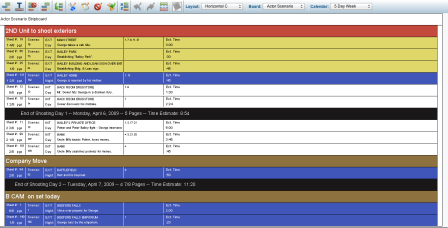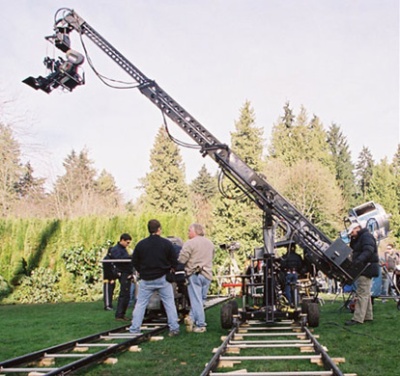If you’ve worked on a show, you’ve likely seen financial waste of varying degrees, from minor wobbles to downright trainwrecks. While sometimes sh*t happens and production just has to deal with it and carry on, more often than not a lot of terrible budget-suck can be avoided. Here are a few tips that apply to many situations (keeping in mind there is no one-size-fits-all method). Paying attention to a few key details can help on your quest to make a good product while staying within budget.
- Rein in your director.
Now the director makes the piece what it is, be it a feature film or a 30 second TV spot. Without them you don’t get your project completed, but that doesn’t mean giving them free reign. Everyone who’s worked more than a day in the industry has likely heard the term “Adult Supervision” muttered around an uncontrolled set, and let me tell you, it’s incredibly important if you want to keep runaway production costs from spiraling out of control.
Producers are there to say no. Someone must wear the black hat. Not always mind you, but their job is to look out for the good of the project and play bad cop when need be. At hour 17 when a director is on his 35th take of an insert shot that could be picked up by 2nd unit, that’s an easy example of when a producer must pull the plug. Unfortunately people want to be liked and often are reluctant to be that guy, but if you put on the producer hat, you have to accept that some days you won’t be terribly liked. Suck it up and keep your project (and budget) on track.
- Rein in rampaging actors (when possible).
Ok, actors are a unique bunch. Folks make fun of them, but when you really consider what they must do to put on a good performance, a bit of flexibility is warranted. I mean let’s not forget Lawrence Fishburn and Hugo Weaving’s epic fight in The Matrix. Even after 16+ hours, bangs & bruises, and horrible allergies from all the dust, they acted like pros and made the fight look amazing.
Here’s the but. BUT, everything is on a schedule and every extra minute spent on something that should be otherwise completed is costing the production money. Be it demanding frivolous alternate takes, or refusing to come out of the trailer while the whole crew is standing around waiting, once again it is the producer’s job to play bad cop, albeit with kid gloves more often than not. I should also mention that I wholeheartedly support shooting extra takes when an actor has interpretations of scenes they want to try, so long as it really may add to the scene and won’t cost the production tens of thousands in overages in the process..
One notable exception to this is when the actor is also the financier. I once worked on a ridiculous film where come shooting call we were looking for the lead. “Ready to shoot” the AD said. “Oh, he went to Texas to do a concert.” Yep, the talent/financier left and didn’t tell anyone. “Ok, we’ll shoot the other parts of the scenes.” “Um, those were all his posse… they went with him.” A quandry, but not insurmountable. “Ok, we’ll shoot the actor who isn’t in his crew.” “Yeah, about that, he heard they were going to Texas, so he flew to Ohio.”
It was the only time I got paid to sit and play Scrabble on set for 8 hours as production tried to figure out literally anything they could shoot. In the end it was one POV shot of someone’s boots… worn by the producer.
- Plan ahead. For real, DO THIS.
Showing up and winging it may work on a student film, but if every minute costs hundreds or thousands of dollars, you’d better damn well know what you’re doing next. This is where pre-production is vital, as is location scouting with the director and their keys. A little forethought can save you literally hours of paying a crew to stand twiddling their thumbs on the clock while ideas are bounced around.
The time for brainstorming is before you have the crew on the clock. I’ve worked with directors who will change their shots for that day’s work, but there are two types. There’s the type who torpedoes the schedule and budget in doing so, and there’s the type who knows that they want to make changes and shows up early, walking the sets and planning their changes before the crew is even ready. The latter is a sign of professionalism, and trust me the crew notices these things.
Remember the 6 P’s: “Proper Planning Prevents Piss Poor Performance.”
- Find ways to reduce needless complexity.
A lengthy scene with 6 people can eat up your whole day, but can some of those characters not be in the scene? Can their dialogue be spoken by another character, thus reducing the number of shots and coverage needed? Can they be out of the room, perhaps even answering from off screen? What can you do to keep the integrity of the scene while reducing its complexity and schedule demands?
Coverage can be death in crowded scenes. If you start doing multiple coverage angles at multiple sizes for multiple characters, pretty soon you’ll not only burn through most of the day shooting the same scene over and over, but you’ll also eventually start to burn your actors out as well. Now sometimes it must be done, and everyone appreciates and understands that, but when it is frivolous, all it does is burn time, money, and patience.
- Do not shoot multiple masters.
Want to piss off your actors and crew, waste time, and look like an amateur? Shoot hours of multiple masters from multiple angles before moving in to coverage. The master should be just that, a master, from which you then get into the meat of the scene with coverage. Shooting multiple masters screams out “I didn’t plan this and am winging it!” Don’t be that person. If you’re truly making it up as you go, the crew and actors will know, and they will lose respect for you eventually. Even if the end result is amazing, you can’t do it often. It is morale killing to spend a 15 hour day on set that could have been 10 just because someone was indecisive and unprepared.
- Keep dolly and crane shots within reason.
Giving a director toys to play with can produce some amazing shots, but it can also cost the production tens of thousands in overages. This comes back to the idea of planning out your day. If you have a dolly shot planned for the morning and a crane shot for the afternoon, great, but if you have those tools and just start making things up it is going to derail your schedule faster than an Amtrak (sorry Amtrak).
This is where dialogue between the “Adults” (remember the term “Adult Supervision”?) and the director. Sometimes for a great bit of inspiration you have to suck it up and get the shot if it is truly worth it. A lot of amazing material has been filmed because of inspiration on the day. The key is knowing when to let them run with it and when to reign it in. Toys are fun to play with, but every dolly, crane, or drone shot requires a lot of time to set up. It’s tough, but this is where the producer must make judgment calls and hope their decision was the right one.
- Storyboard if you can afford it.
Ok, I may be a bit biased, my cousin, Tony Liberatore, (not his board shown above) is an amazing storyboard artist who comes up with brilliant shots and transitions on the fly for some of the biggest films out there (Fast and Furious, Captain America, and many more). The thing is, a good storyboard artist will help a director approach the day with a concrete plan. A course of action. A visual map of what they MUST get that day. If they can get more, fantastic, but the storyboard really helps keep the production on track.
Paul Hunter is a music video director whose shoots I’ve worked on in the past, and let me tell you that man is meticulous in his storyboarding. Now we all know music video shoots are almost always ridiculously long days, but Paul is a rarity in that he not only gets every single shot on his boards, but once he has them he then gets additional shots he’s come up with if reasonable given the schedule. His work ethic is impressive, and it shows in the smoothness of his shoots. It’s also a big reason so many of us loved working with him, it’s always a pleasure working with a pro.
Even if you forget everything you’ve just read, try to keep this one thought in your head: Whether you work on tiny productions or massive projects, every minute wasted is money wasted, and boy does it add up. Strive to make every minute count and you’ll not only save money, but will also most likely find your project will go smoother in nearly all respects.
Be sure to check out my Pulse articles on LinkedIn
//









